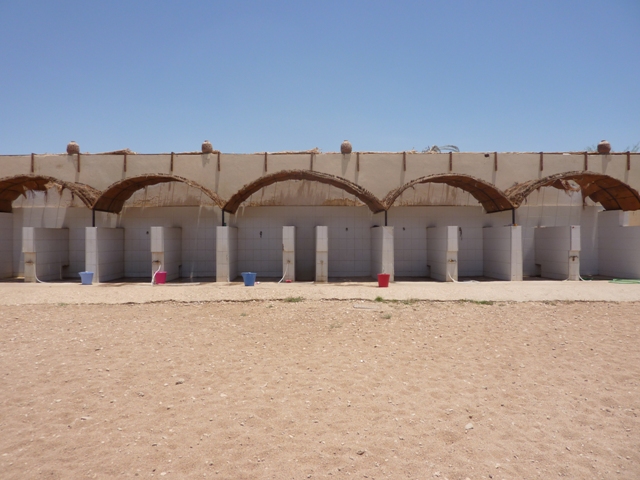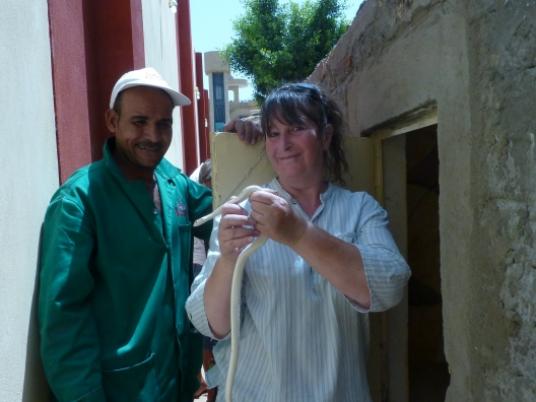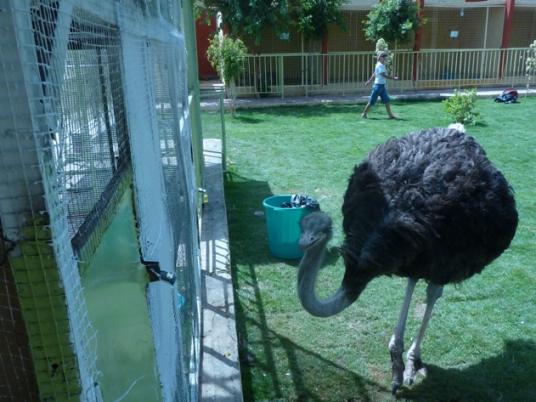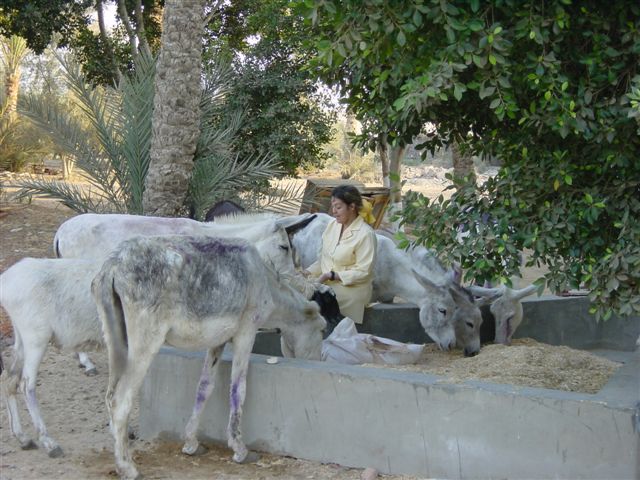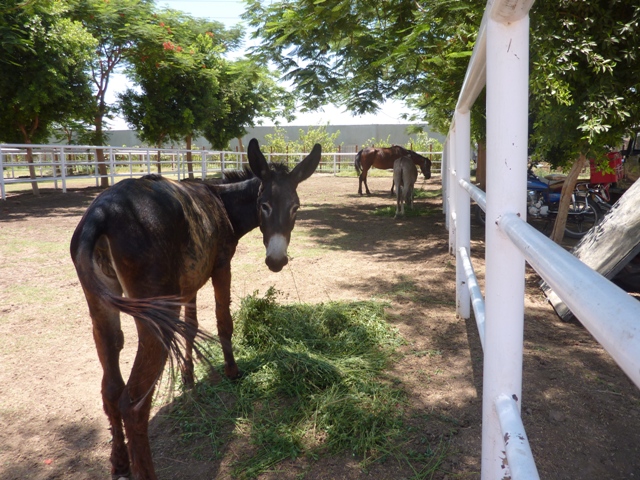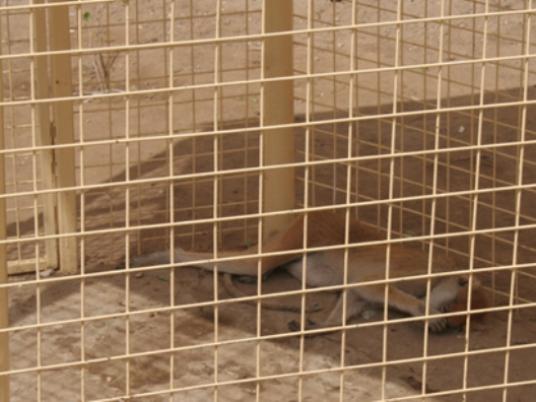
Animal Care in Egypt was never meant to be a hospital, and El Nada Land was never meant to have a zoo. But since the Luxor theme park diversified into animals-in-cages, it has been on a collision course with the cross-town animal welfare activists. It is a tale of two facilities. On one side is a fledgling veterinary services charity swamped with work. On the other is a tourist business looking to make the best of bad times.
Somewhere in the middle is ACE manager Kim Taylor. Born in London, she has lived in Luxor for 15 years and operated Animal Care in Egypt for 12. About town she is known to stop her truck, get out and seize the whips of carriage drivers she has seen beating their nags.
ACE began in 2000, at a small rented place with shower stalls to prevent harness sores. But it was quickly overwhelmed by the need for veterinary services.
“When people bring an animal with a leg hanging off,” Taylor says, “you can’t just wash them.”
Four years ago, the charity built its high-walled compound in a sugar-cane field on the eastern edge of Luxor. It employs three vets full-time and one part-time. The animals and their owners arrive in the early morning and keep up a steady stream through the day: in 2011, ACE had 74,260 animals through its gates, an average of 75 a day.
Mostly it treats donkeys and horses. The complaints are familiar: this one is not eating, this one is not urinating, this stallion has been in a fight with another, this one has been in a road accident, this one has saddle sores.
The suffering animals are medicated, operated on, stitched up, washed, fed and showered. If they can’t be fixed, they’re put down painlessly. It’s all done for free. Much of the funding comes from the UK, as well as donations of out-of-date surgical supplies and equipment. Overseas veterinary students volunteer for months at a time. Its patron is the baby-faced British comedic actor Martin Clunes, of "Men Behaving Badly" fame. Curiously, the facility is the No. 3 recommendation on the TripAdvisor website, behind Valley of the Kings and Karnak Temple.
But for all this, some days the remote high-walled compound can seem like an outpost, says its manager. Although it hosts excursions for the local school kids, mostly the message of animal welfare seems to fall on deaf ears.
El Nada Land's zoo opened on 18 April of this year. Taylor and other volunteers have been paying visits every day since then. Today, Taylor bangs on the handsome metal gates of the theme park. She wants to be let in. The gates remain shut. She is told to go around to the theme park entrance and enter beside the rather forlorn-looking ‘House of Horrors.’ The ‘zoo’ is a large, grassed courtyard with a hanging grape arbor and a line of cages on the far wall. These hold two gazelles, two swamp cats, some Egyptian tortoises and a party of peacocks. A pair of ostriches patrol the lawn. In standalone cages are two black-faced civet monkeys and Australian budgerigars. Nearby, but out of sight, are boa constrictors, cobras and slithering handfuls of vipers.
Taylor hand-picks two dead vipers.
“They haven’t eaten for two months,” she scolds. Two months after the zoo opened to great fanfare with a lion cub, the fanfare has faltered, the lion cub has gone on to better things and the zoo still does not have a license.
Not that this pleases the ACE manager: she wants the zoo to stay open.
“If we shut it down, we just drive the business underground,” she says.
In fact, when the Environment Ministry first announced they were visiting for an inspection, Taylor says, the zoo owner herded the animals from their cages, out the gates and into the theme-park amphitheatre.
“He was worried they would confiscate the animals, and he would lose his money. We were also worried the animals would be confiscated. Then they would have been taken to Giza Zoo,” she says.
Taylor and others felt the El Nada Land animals had a better chance of a good life here, at a theme-park bestiary, than at the national zoo, which is notoriously overcrowded and underfunded.
And so the animal welfare people have entered into an unnatural alliance with the zoo owner.
Taylor does not want to endorse the business, but she does want to able to advise its owner, Mahmoud Sadeek. It’s a difficult bind, but already there have been good results: shade and ventilation for the snakes, more toys for the monkeys, more food for the gazelles.
Sadeek arrives later in the day and joins his two British advisers under the grape arbor. He appears bemused yet affable. They share a Coke. It’s a charged moment, replete with the awkward dynamics of two foreign women advising an Egyptian man on how to run his business.
Sadeek says he is “not at all” annoyed at being told what to do.
Owning animals has been a lot more work and a lot more expensive than he expected. But unlike the animal welfare people, he has to worry about the bottom line, too. He is learning as he goes, he says. The coffee shop idea had come first. Then a friend advised adding a few critters to the mix, like they were doing at resorts in Sharm el-Sheikh, and Sadeek went bargain-hunting for gazelles, monkeys, snakes and so on in Cairo, Alexandria and Sinai. They were easy to buy, even without a license.
So far the zoo averages about 40 visitors a night. He expects more will come once the license is granted and the zoo can open throughout the day.
“But we have to proceed slowly, slowly,” he adds. The zoo, for that matter, is no mere zoo. It is an entertainment complex, with a restaurant and a cafe, and it is attached to a theme park. The next purchase will be a billiards table, so patrons can shoot pool beside the ostriches.
He says there are three aspects to El Nada Land: the theme park, the wedding venue and the zoo. In the future, he says, there will be an aqua park.
Business has been down since 25 January 2011. But the zoo might encourage more patrons through the turn-styles, Sadeek hopes.
What is happening in Luxor describes, in a simplified way, the fault lines between notions of the proper treatment of animals.
Anecdotal reports suggest these divisions are coming to a head in Egypt. While ad-hoc bestiaries added to cafes and restaurants is said to be a growing trend, animal welfare activists are also gaining in confidence. Meanwhile, at least in Luxor, the downturn in tourism has put the beasts of tourism — donkeys and horses — in a vulnerable predicament.
But Luxor also differs from Cairo: Here, animal welfare is more akin to social welfare. It’s more urgent. A Luxor donkey can be a family’s livelihood, while this is not often said of a Cairene pet.
“People say, ‘You are a foreign charity, you should help the children’,” Taylor says. “But if we can keep an old man’s donkey healthy, we can keep that man working. From our point of view, we’re in it to help the animals. From the outsider’s point of view, we’re in it for society. We’re doing what we can do to make animals as comfortable as possible while they’re here. If a donkey is lame, you fix it and give it back. All the stuff in between is just politics.”

